研究課題
Genetic assessment of attempted eradication program on invasive ant: fire ant and Argentine ant as examples – 1
外来アリ駆除プログラムの遺伝子アセスメント-ヒアリとアルゼンチンアリを例として
研究組織
| 代表者 | Chin-Cheng Yang (RISH, Kyoto University) |
|---|---|
| 共同研究者 | 吉村剛(京都大学生存圏研究所) |
| 関連ミッション |
|
研究概要
Biological invasions of ant species are regarded as one of the major causes of global biodiversity loss, environmental change and reduced humanosphere sustainability. Albeit eradication efforts can be implemented to mitigate the effects of ant invaders, lack of a practical assessment system on status and effectiveness often leads to a failure of eradication campaigns. The objectives of this proposal therefore aim to 1) frame up the world-first monitoring scheme for the eradication program on invasive ants using temporal genetic approaches and 2) demonstrate the utility of the evaluation system on maximizing long-term success of ant eradication program.
The above-mentioned objectives are primarily based on two theories including “genetic bottleneck effect” and “survivor or re-invader hypothesis”. Utilizing population genetic approaches, this project is able to detect dynamics of the effective population size for focal invasive ant and monitor the temporal change of genetic diversity in various stages of eradication campaigns. The discovery of reduced genetic diversity in post-eradication phase, as a characteristic of genetic bottleneck effect, may indicate the eradication efforts have taken effects in bringing down the effective population size of the focal invasive ant. On the other hand, the test of “survivor or re-invader” allows us to understand the individuals discovered in post-eradication phase are results of survivors from the eradication attempt or re-invaders from another existing population(s).
Results from the present project not only assist in determining if eradication efforts exert survival pressure against focal invasive ant population, but also in identifying the causes of eradication failure. In conclusion, such development of genetic monitoring scheme is expected to strengthen our capacity of minimizing failure risks by implementing remediation procedures, and, more importantly, to reinforce the eradication commitments from the government, publics and academics.

Fig. A workflow showing the scientific design of this current project with two primary aims: ①level of genetic bottleneck as an index for the effectiveness of eradication efforts; ② test of “survivor or re-invader” to assess the causes of eradication failure.
ページ先頭へもどる
2016年8月4日作成


